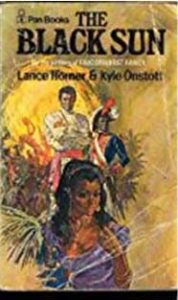Novels and History’s Bloody Details
I have a friend who retains nothing from the way history is usually taught in classes, so she reads historical novels about the periods she wants to learn about. The novels make the history come alive for her so she can remember it.
I understand this. Many years ago, in planning a trip to Haiti. I tried reading nonfiction about Haitian history, but I simply couldn’t retain the salient facts. Then I read a lurid novel called The Black Sun by Lance Horner and Kyle Onstott. In the novel, a young American from Boston travels to Haiti as the  bloody revolution begins in 1791. The revolution ended in 1804 with the triumph of the black slaves. The major figures of that revolution, especially Henri Christophe, Toussaint L’Ouverture, and Jean-Jacques Dessalines, are vividly described in the book. Dessalines became the first leader of Haiti after the revolution. The novel described him as a brutal revengeful man and that was the way he ruled. This was confirmed in reading nonfiction about Haiti’s history, where it seemed every succeeding president was more brutal than the last.
bloody revolution begins in 1791. The revolution ended in 1804 with the triumph of the black slaves. The major figures of that revolution, especially Henri Christophe, Toussaint L’Ouverture, and Jean-Jacques Dessalines, are vividly described in the book. Dessalines became the first leader of Haiti after the revolution. The novel described him as a brutal revengeful man and that was the way he ruled. This was confirmed in reading nonfiction about Haiti’s history, where it seemed every succeeding president was more brutal than the last.
We also read The Comedians by Graham Greene, a novel set in Haiti during the regime of Francois “Papa Doc” Duvalier, a brutal dictator of Haiti from 1957 to 1971. The novel was later made into a movie starring Elizabeth Taylor and Richard Burton. Duvalier’s vicious security police were known as the “Tonton Macoute.”
We visited Haiti during Duvalier’s last year as “President for Life.” When we arrived at the Port Au Prince airport, my husband and I were grilled by the security police because my husband had indicated he was a journalist on the immigration card. “What paper?” they asked again and again as everyone else left the airport, rolls of barbed wire were spread across the landing strip and guard dogs let loose. Our interrogator finally drove us to our hotel, deliberately running over a dog on the way, and we were greeted by the owner’s wife who informed us the electricity was out—one of the frequent blackouts. She immediately served us rum punches, and we joined the group of locals on the verandah.
We stayed at the Grand Hotel Olaffson, the same hotel where Greene stayed and amused ourselves by pointing out places and people mentioned in the book. There was a newspaper reporter with his typewriter set up in the bar. According to the book, he was one of Duvalier’s spies. We found a body in the swimming pool. Actually, the pool was drained and one of the local Haitians was sleeping in it. The story centers on a small group of people, “the comedians,” who come to Haiti for various reasons and their drama is played out against the backdrop of Duvalier’s brutal dictatorship.
Moving forward, last October I visited Yosemite National Park. My companion was Nevada Barr’s book High Country, which is set in Yosemite. I enjoy her books because each one takes place in a different national park where her character, Anna Pigeon, is stationed as a park ranger. The books describe how the park system works, the natural environment of the park, and the issues relevant to that park. In High Country, Anna Pigeon is working undercover in the dining hall to try to find out why several park employees have disappeared. It was a pleasure to explore that park along with Anna Pigeon only without the dangers and the exertion. After reading the book, I came across an additional note about a plane that actually crashed in Yosemite in 1977, carrying 10,000 pounds of marijuana.
The point I’m making here is that history is much more fun and interesting when it comes with blood, gore, and the details of human living in a novel.
Eileen McIntire
Eileen has ridden a camel in the Moroccan Sahara, fished for piranhas on the Amazon, sailed in a felucca on the Nile, and lived for three years on a motorsailer, exploring the coast from Annapolis to Key West. Eileen has many years experience writing, editing and designing all manner of publications for nonprofits and professional associations. She is now co-owner of Summit Crossroads Press, which publishes books for parents, and its fiction imprint, Amanita Books. The inspiration for her 90s Club mystery series springs from meeting a slim, attractive woman at a pool party who was the only one actually in the pool swimming laps, and she was 91 years old. Since then, Eileen has collected articles about people in their 90s—and 100s—who are still active, alert and on the job. She often speaks at retirement villages on “Old Dogs, New Tricks.”